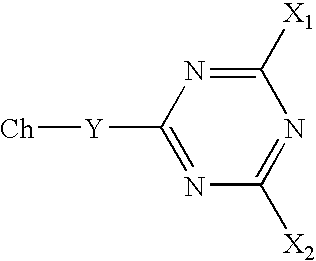Method of Dyeing a Substrate With a Reactive Dyestuff in Supercritical or Near Supercritical Carbon Dioxide
a technology of reactive dyestuffs and substrates, applied in dyeing processes, chemistry apparatus and processes, fibre treatment, etc., can solve the problems of high production cost waste water, etc., and achieve excellent fixation, high reaction rate, outstanding washfastness and fastness to rubbing
- Summary
- Abstract
- Description
- Claims
- Application Information
AI Technical Summary
Benefits of technology
Problems solved by technology
Method used
Image
Examples
example 1
[0050] A piece of 0.25 g of mercerized cotton was pre-treated in a fluid medium consisting of 20 g of methanol as hydrogen bond acceptor. The pre-treatment was carried out at 40° C. and 1 bar by immersing the cotton in the methanol and gently shaking for 12 h. The pre-treated cotton was removed from the fluid medium and transferred as such for dyeing treatment. The remaining methanol in the cotton after the pre-treatment was about 60% by weight of the cotton substrate.
[0051] The dyeing test was carried out in a high-pressure batch reactor designed to carry out experiments under supercritical conditions. The reactor consisted of a 150 mL pressure vessel provided with a pressure manometer and a needle valve.
[0052] The piece of pre-treated cotton was placed into the batch reactor together with the reactive disperse dye (4,6-difluoro-N-[4-(phenyldiazinyl)phenyl]-1,3,5-trazin-2-amine) and a co-solvent. The amount of dye used was 10% by weight of the fibre (owf). The applied co-solvent ...
example 2
[0060] The experimental procedure described in example 1 was applied to 0.25 g of mercerized cotton. In this experiment instead of methanol as co-solvent, ethanol was used, also in a concentration of 2% by weight of carbon dioxide. The result after 4 hours dyeing at 140° C. and 300 bar was a yellow piece of cotton that was evenly dyed. The K / S value after dyeing was 25.3 and K / S after extraction was 19.7
example 3
[0061] A piece of 0.25 g of mercerized cotton was dyed following the procedure described in example 1, except that this time the reactive disperse dye employed was 4,6-dichloro-N-[4-(phenyldiazinyl)phenyl]-1,3,5-trazin-2-amine. The dichlorotriazinyl derivative was applied at an owf of 5% as an owf of 10% was found to cause damage to the cotton as a result of the production of significant quantities of hydrochloric acid. The dyeing process with the dichlorotriazinyl derivatised dyestuff was carried out for 7 h.
[0062] The result of this experiment was a yellow piece of cotton that was evenly dyed. The K / S values after dyeing and extraction were 9.0 and 7.7 respectively. Thus, it can be concluded that the piece of cotton dyed with the difluorotriazinyl derivatised dye shows a stronger colouration than the cotton dyed with the dichlorotriazinyl derivatised dye, even when the dyeing time employed for the latter dye was 3 hours longer than for the difluorotriazinyl derivatised dye.
PUM
| Property | Measurement | Unit |
|---|---|---|
| pressure | aaaaa | aaaaa |
| temperature | aaaaa | aaaaa |
| critical pressure | aaaaa | aaaaa |
Abstract
Description
Claims
Application Information
 Login to View More
Login to View More - R&D
- Intellectual Property
- Life Sciences
- Materials
- Tech Scout
- Unparalleled Data Quality
- Higher Quality Content
- 60% Fewer Hallucinations
Browse by: Latest US Patents, China's latest patents, Technical Efficacy Thesaurus, Application Domain, Technology Topic, Popular Technical Reports.
© 2025 PatSnap. All rights reserved.Legal|Privacy policy|Modern Slavery Act Transparency Statement|Sitemap|About US| Contact US: help@patsnap.com

